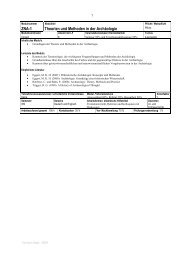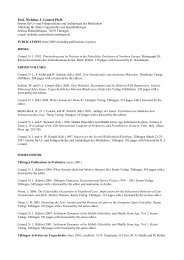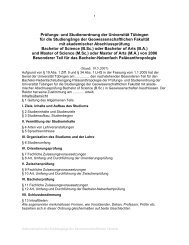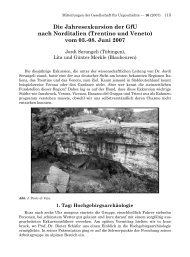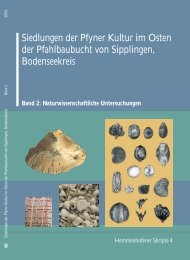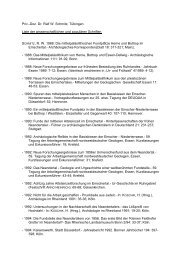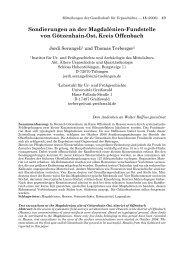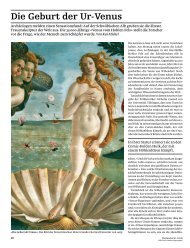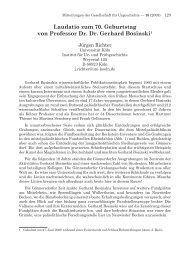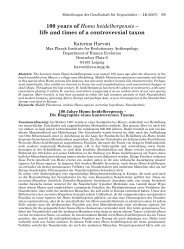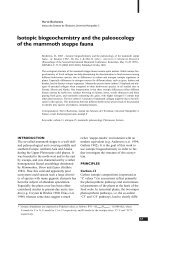bronze age environment and economy in the troad - Universität ...
bronze age environment and economy in the troad - Universität ...
bronze age environment and economy in the troad - Universität ...
Create successful ePaper yourself
Turn your PDF publications into a flip-book with our unique Google optimized e-Paper software.
The geographical position of <strong>the</strong> Troad between <strong>the</strong> Black Sea<br />
region, <strong>the</strong> Aegean <strong>and</strong> <strong>the</strong> prehistoric settlements of Inner<br />
Anatolia, def<strong>in</strong>es it as a focal po<strong>in</strong>t of cultural <strong>and</strong> economic<br />
relations between <strong>the</strong>se regions. However, no comprehensive<br />
studies of Bronze Age <strong>environment</strong> <strong>and</strong> <strong>economy</strong> have been<br />
conducted before <strong>in</strong> <strong>the</strong> Troad.<br />
This archaeobotanical <strong>in</strong>vestigation is based on <strong>the</strong> study of<br />
c. 270000 seed rema<strong>in</strong>s, belong<strong>in</strong>g to some 336 types (186<br />
species of 43 plant families) collected by <strong>the</strong> author <strong>in</strong> three<br />
years of fieldwork between 1993 <strong>and</strong> 1995. In all, 38 samples<br />
were studied from Chalcolithic <strong>and</strong> Early Bronze Age levels at<br />
Kumtepe, <strong>and</strong> 325 samples from Early, Middle <strong>and</strong> Late<br />
Bronze Age levels at Troy. The overall sequence offers a rich<br />
dataset for study of agricultural <strong>economy</strong> <strong>and</strong> impact of<br />
humans on <strong>the</strong> <strong>environment</strong> over a span of approximately 3800<br />
years.<br />
Increas<strong>in</strong>g human <strong>in</strong>fluence will be demonstrated from<br />
Kumtepe B. It will be shown that <strong>the</strong> result<strong>in</strong>g scarcity of wood<br />
forced <strong>the</strong> use of dung for fuel, but this could not stop heavy<br />
soil erosion processes occurr<strong>in</strong>g at least from Late Bronze Age<br />
Troy onwards.<br />
This publication is based on my PhD <strong>the</strong>sis submitted at <strong>the</strong><br />
Faculty of Geosiences (University of Tüb<strong>in</strong>gen) <strong>in</strong> June 1997.<br />
The work benefited from <strong>the</strong> advice of my exam<strong>in</strong>ers Prof. Dr.<br />
Dr. Hans-Peter Uerpmann (Inst. für Ur- und Frühgeschichte,<br />
Univ. Tüb<strong>in</strong>gen) <strong>and</strong> Dr. Glynis Jones (Dept. of Archaeology<br />
<strong>and</strong> Prehistory, Sheffield).<br />
Abstract<br />
Acknowledgments<br />
abstract<br />
This work will demonstrate that changes occurred not solely <strong>in</strong><br />
<strong>the</strong> range <strong>and</strong> relative proportions of crop species <strong>and</strong> <strong>the</strong><br />
associated weed spectra, but also <strong>in</strong> <strong>the</strong> locations of fields for<br />
various reasons. The diversity <strong>in</strong> crops <strong>and</strong> <strong>the</strong> exploitation of a<br />
new range of species <strong>in</strong>creased from <strong>the</strong> Neolithic to Late<br />
Bronze Age, <strong>and</strong> different cultivation methods such as<br />
polycropp<strong>in</strong>g dur<strong>in</strong>g Middle Bronze Age Troy, <strong>and</strong> chang<strong>in</strong>g<br />
<strong>in</strong>tensity <strong>in</strong> field man<strong>age</strong>ment dur<strong>in</strong>g different periods,<br />
determ<strong>in</strong>ed <strong>the</strong> development of agriculture <strong>in</strong> <strong>the</strong> Troad.<br />
Overall, <strong>the</strong> economic patterns at Troy are strik<strong>in</strong>g similar to<br />
those of <strong>the</strong> simultaneous Aegean sites, particularly dur<strong>in</strong>g <strong>the</strong><br />
Late Bronze Age. An archaeobotanical perspective is offered<br />
for <strong>the</strong> socio-economic development of Troy. Dur<strong>in</strong>g Early<br />
Bronze Age <strong>the</strong> settlement was rural but with a stratified social<br />
structure, <strong>and</strong> was eng<strong>age</strong>d <strong>in</strong> subsistence farm<strong>in</strong>g. In Middle<br />
Bronze Age <strong>the</strong>re is evidence for <strong>the</strong> production of surplus on<br />
<strong>the</strong> household level, with <strong>the</strong> appearance of small-scale<br />
stor<strong>age</strong>. Dur<strong>in</strong>g Troy VI <strong>and</strong> VIIa (Late Bronze Age) surplus<br />
supplies from large-scale, specialised crop production were<br />
probably appropriated from surround<strong>in</strong>g vill<strong>age</strong>s.<br />
namely Amy Bogaard <strong>and</strong> John Meadows, who also helped<br />
with improv<strong>in</strong>g <strong>the</strong> English.<br />
Dr. Konstant<strong>in</strong> Pustovoytov (RAS Moscow) provided<br />
<strong>in</strong>formation <strong>and</strong> results of soil science <strong>and</strong> realised <strong>the</strong><br />
radiocarbon dat<strong>in</strong>g of grape pips.<br />
The people of <strong>the</strong> Troy project (Prof. Dr. Manfred Korfmann<br />
<strong>and</strong> collaborators), namely Dr. Peter Jablonka <strong>and</strong> Utta<br />
Gabriel, M.A., helped with answer<strong>in</strong>g archaeological questions<br />
at Troy <strong>and</strong> Kumtepe <strong>and</strong> provided samples <strong>and</strong> meticulous<br />
documentation.<br />
I’m thankful for <strong>in</strong>terest<strong>in</strong>g discussions <strong>and</strong> encour<strong>age</strong>ment<br />
from <strong>the</strong> colleagues <strong>and</strong> friends <strong>in</strong> Tüb<strong>in</strong>gen <strong>and</strong> Sheffield,<br />
Special thanks I owe Dr. Mark Nesbitt (Dept. of Archaeology,<br />
London), who helped with valuable comments <strong>and</strong> his untir<strong>in</strong>g<br />
patience <strong>in</strong> read<strong>in</strong>g <strong>the</strong> first drafts of this work. Mark also<br />
provided access to his comparative collection of Turkish<br />
grasses <strong>and</strong> <strong>the</strong> SEM apparatus <strong>in</strong> <strong>the</strong> Institute of Archaeology<br />
of UC London.<br />
VII




